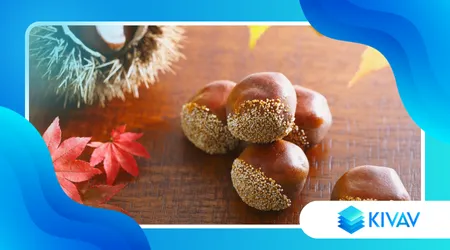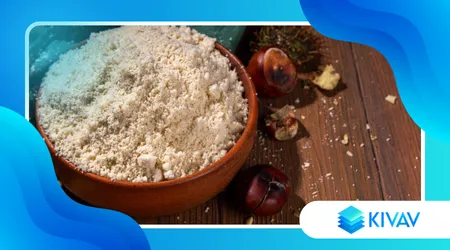Chestnut flour: how to use it for desserts and rustic recipes

Chestnut flourThere is a flavor that immediately evokes autumn woods, a crackling fire, and the rustic atmosphere of the countryside.
Announcements
It is that of the chestnut flour, an ancient ingredient that is rediscovering a new, deserved popularity.
Many know it only for the classic castagnaccio, but its potential goes far beyond.
This versatile and aromatic ingredient opens up a world of possibilities for both pastry and savory recipes.
Its sweet and enveloping flavor makes it perfect for rustic desserts and original creations.
Announcements
The use of chestnut flour dates back centuries, when it was a staple food in mountain areas.
Often nicknamed “the bread of the poor,” it has fed entire generations in times of famine.
Today, fortunately, it is no longer seen as a necessity, but as a valuable ingredient.
Its fine texture and unmistakable aroma add a unique note to any dish.
It's not just about flavor, but also nutritional benefits. Rich in fiber and minerals, chestnut flour is an excellent gluten-free alternative.
Furthermore, it's a source of complex carbohydrates and contains less fat than other flours. Chestnuts are naturally sweet, which allows for a reduction in sugar content.
It's a smart and healthy ingredient for those looking for alternatives. An interesting fact emerges from the 2024 Coldiretti report.
85% Italian farms have seen an increase in demand for chestnut-based products.
This data highlights a growing interest in local products and traditions.
The magic of pastry making with chestnut flour
When you think about pastry making, the chestnut flour It's not the first thing that comes to mind. Yet, it's capable of giving cakes and cookies a unique softness and flavor.
Its slightly nutty aroma pairs beautifully with chocolate and fruit.
A perfect example is a chocolate and pear cake with the addition of chestnut flour.
The result is a moist, dense, and incredibly flavorful dessert. Its natural sweetness reduces the need for added sweeteners.
It's ideal for those who want to make delicious desserts without overdoing it. Another great classic is castagnaccio, a simple yet iconic dessert.
Sometimes enriched with pine nuts, raisins and rosemary, castagnaccio is a taste experience.
But why stop there? You can experiment with muffins, pancakes, or plum cakes. Try replacing a quarter of the wheat flour with chestnut flour.
Learn more: Pane carasau: history and culinary uses of this crispy Sardinian bread.
You'll get a softer texture and a deeper, more rounded flavor. It's like adding a touch of woodsy flavor to a simple homemade dessert.
It's a simple way to take a common recipe to the next level.

Rustic and savory recipes: the other side of chestnut flour
Limiting yourself to sweets would be a serious mistake and a missed opportunity. The versatility of the chestnut flour It is also evident in savoury preparations.
Think gnocchi, fresh pasta, or even bread and focaccia. Its presence adds an earthy flavor and unique texture to the dough.
Imagine potato and chestnut flour gnocchi tossed with butter and sage. The sweet-savory flavor creates an unexpected and delicious gastronomic balance.
Interesting: Using spices and herbs in Italian cuisine
Another idea is homemade pasta made with chestnut flour and semolina. This pasta pairs beautifully with game or mushroom sauces.
Or, try making a slightly sweet and aromatic focaccia or bread. Adding a touch of chestnut flour to the bread makes it more interesting.
Consider using it to bread meats or vegetables. It imparts a golden crunch and a unique flavor to every bite.
Chestnut flour is a culinary chameleon. It adapts to both sweet and savory dishes, taking the best of both worlds.
One ingredient, infinite possibilities: tips and pairings
Use the chestnut flour It may require a little attention. Due to its gluten-free nature, it tends to make dough less elastic.
++ Risotto with Castelmagno cheese and pears: Piedmontese elegance in the kitchen.
It's therefore advisable to mix it with other flours for better results. The golden rule is not to exceed 30-40% of the total dough weight.
For desserts, it pairs well with vanilla, chocolate, figs, and walnuts. For savory recipes, it pairs well with cheese, mushrooms, herbs, and lard.
Below is a table to help you choose the best pairings.
| Pairing (Sweet) | Pairing (Savory) |
| Dark chocolate | Porcini mushrooms |
| Pears and apples | Sage and rosemary |
| Orange and ginger | Goat cheese |
| Honey | Speck and bacon |
| Walnuts and almonds | Sausage |
There chestnut flour It's not just an ingredient, it's a story. It tells of a thousand-year-old tradition and a deep connection to the land.
Sure, it requires a bit of experimentation, but the results are surprising. It's a sensory journey through the authentic and genuine flavors of our country.
Why not rediscover a culinary treasure that has been passed down to us?

the future of an ingredient from the past
The rediscovery of the chestnut flour It's a positive sign for the future of our gastronomy. It demonstrates a renewed interest in genuine, healthy, and locally sourced products.
In a world where food is often standardized, chestnut flour is an exception. It expresses a connection to nature and the roots of our cuisine.
A return to our roots that's also a step toward a more conscious diet. Its impact is visible not only on our tables, but also on the local economy.
Its cultivation helps preserve forests and rural traditions. Experimenting with it is a way to honor the past and look to the future.
It's time to rediscover the hidden potential of this humble and precious ingredient.
Frequently Asked Questions
What is chestnut flour and how is it produced?
It is a flour obtained from the drying and subsequent grinding of chestnuts.
The chestnuts are first dried slowly, often in traditional dryers, and then finely ground.
Does chestnut flour contain gluten?
No, chestnut flour is naturally gluten-free and is an excellent alternative for those with celiac disease or gluten intolerance.
Can I completely replace 00 flour with chestnut flour?
Generally, it is not advisable to replace all 00 flour with chestnut flour.
For desserts, a percentage between 20% and 40% is ideal to ensure the right consistency and flavor, while for bread and pasta it is recommended not to exceed 30%.
How do you store chestnut flour?
Because it's high in sugar, it tends to spoil more easily. It's best to store it in an airtight container in a cool, dry place, away from heat sources.
For optimal and prolonged storage, it can also be stored in the refrigerator or freezer.
